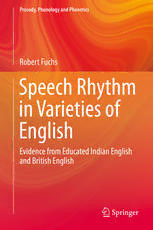
Speech Rhythm in Varieties of English: Evidence from Educated Indian English and British English PDF
Preview Speech Rhythm in Varieties of English: Evidence from Educated Indian English and British English
Prosody, Phonology and Phonetics Robert Fuchs Speech Rhythm in Varieties of English Evidence from Educated Indian English and British English Prosody, Phonology and Phonetics SeriesEditors DanielJ.Hirst,CNRSLaboratoireParoleetLangage,Aix-en-Provence,France QiuwuMa,SchoolofForeignLanguages,TongjiUniversity,Shanghai,China HongweiDing,SchoolofForeignLanguages,TongjiUniversity,Shanghai,China The series will publish studies in the general area of Speech Prosody with a particular(butnon-exclusive)focusontheimportanceofphoneticsandphonology inthisfield.Thetopicofspeechprosodyistodayafarlargerareaofresearchthan isoftenrealised.Thenumberofpapersonthetopicpresentedatlargeinternational conferencessuchasInterspeechandICPhSisconsiderableandregularlyincreasing. Theproposedbookserieswouldbethe naturalplace topublishextendedversions of papers presented at the Speech Prosody Conferences, in particular the papers presentedinSpecialSessionsattheconference.Thiscouldpotentiallyinvolvethe publicationof3or4volumeseverytwoyearsensuringastablefutureforthebook series. If such publications are produced fairly rapidly, they will in turn provide a strong incentive for the organisation of other special sessions at future Speech Prosodyconferences. Moreinformationaboutthisseriesathttp://www.springer.com/series/11951 Robert Fuchs Speech Rhythm in Varieties of English Evidence from Educated Indian English and British English 123 RobertFuchs UniversityofMünster Münster,Nordrhein-Westfalen,Germany ISSN2197-8700 ISSN2197-8719 (electronic) Prosody,PhonologyandPhonetics ISBN978-3-662-47817-2 ISBN978-3-662-47818-9 (eBook) DOI10.1007/978-3-662-47818-9 LibraryofCongressControlNumber:2015949227 D6 SpringerSingaporeHeidelbergNewYorkDordrechtLondon ©SpringerScience+BusinessMediaSingapore2016 Thisworkissubjecttocopyright.AllrightsarereservedbythePublisher,whetherthewholeorpartof thematerialisconcerned,specificallytherightsoftranslation,reprinting,reuseofillustrations,recitation, broadcasting,reproductiononmicrofilmsorinanyotherphysicalway,andtransmissionorinformation storageandretrieval,electronicadaptation,computersoftware,orbysimilarordissimilarmethodology nowknownorhereafterdeveloped. Theuseofgeneraldescriptivenames,registerednames,trademarks,servicemarks,etc.inthispublication doesnotimply,evenintheabsenceofaspecificstatement,thatsuchnamesareexemptfromtherelevant protectivelawsandregulationsandthereforefreeforgeneraluse. Thepublisher,theauthorsandtheeditorsaresafetoassumethattheadviceandinformationinthisbook arebelievedtobetrueandaccurateatthedateofpublication.Neitherthepublishernortheauthorsor theeditorsgiveawarranty,expressorimplied,withrespecttothematerialcontainedhereinorforany errorsoromissionsthatmayhavebeenmade. Printedonacid-freepaper SpringerScience+BusinessMediaSingaporePteLtd.ispartofSpringerScience+BusinessMedia(www. springer.com) Preface ThismonographisarevisedversionofmyPhDthesissubmittedtotheUniversityof Münster, Germany (Westfälische Wilhelms-Universität Münster), in 2013. Before moving to Münster, I spent the first year of my PhD studies at the University of Augsburg, Germany. Many people have contributed to the successful completion of the thesis and the processof turningit into a book.My supervisor,Ulrike Gut, providedunwaveringsupporttotheprojectatalltimes.Shewasextremelygenerous withhertime,providingpromptandvaluablefeedbackatallstages,butalsogiving methetimeandspacetodevelopmyownideas.Icouldnothavewishedforabetter supervisor. Volker Dellwo (University of Zurich) served as external examiner for the thesisandprovidedextremelyvaluablefeedbackatvariousstages. Thanksare alsoduetoDagmarDeuberandKlaus-MichaelKöpcke,whoservedasmemberand chair,respectively,of the examinationcommittee.Claudia Langefirst broughtme intocontactwiththestudyofWorldEnglishesandIndianEnglishinparticularand pavedthewayforallmyfutureprojectsinthisarea.MadhumeetaSinhaandSatish PoduvalwereextremelycordialandhelpfulwhenIfirstcametoHyderabadin2006 forasemesterabroadduringmyMAstudiesandduringallsubsequentvisits. This project would not have been possible without the speakers who so gen- erously allowed me to record them and those who subsequently participated in the perception experiments. I would like to thank all those who gave their time to support this research. Special thanks are due to Hemalatha Nagarajan and her colleagues, who welcomed me at the English and Foreign Languages University (EFLU, Hyderabad,India) in 2012 and 2013 for short research stays. The cordial welcomeprovidedbystaffandstudentsatEFLUmademyfieldworknotonlymuch easier than anticipated but also an extremely pleasant and fulfilling experience. The second of these research stays was partially supported by Heinrich-Hertz- Foundation, Germany, whose support is gratefully acknowledged. Madhumeeta Sinha and Hemalatha Nagarajan allowed me to approach potential participants in their classes. Tiasa Bal, Ganesh Sinisetty, Chandrasekar Kandharaja, Angana Adhikari and Apala Das helped with recruiting participants and running the perception tasks. Additionally, Marije van Hattum administered a perception task v vi Preface tooneofherclassesattheUniversityofManchester.ElviraHadzicandEvaFischer helpedwith checkingword alignmentin the transcriptionsof the productiondata. TheBritish EnglishproductiondatacomesfromtheDyViSdatabase(Nolanetal. 2006),andIamgratefultoitscreatorsformakingtheirdatabasepubliclyavailable. ThetextandinterviewtechniqueusedtogathertheIndianEnglishproductiondata were also developedin the DyViS project. Thanks are also due to Volker Dellwo forprovidingrecordingsofBritishEnglishspeakersthatwereusedinthe‘cocktail partyeffect’experiments.Iwouldalsoliketothanktheserieseditorsandeditorial staffatSpringerfortheirsupportduringallstagesofthepublicationprocess. Parts of the results documented in this monograph were presented at various stagesduringthePhDseminarsinEnglishLinguisticsattheUniversitiesofMünster andAugsburg,thePhDseminarsoftheGraduateSchoolforEmpiricalandApplied Linguistics at the University of Münster, the Workshop on ‘Norms and Standards in Indian English and Other South Asian Englishes’ (2014) at the University of Münster, at Speech Prosody 7 in Dublin in 2014, at the (Post-)Doctoral Spring School of the International Society for the Linguistics of English in Freiburg in 2013, at invited talks at the Centre for English Language Studies of Hyderabad Central University, India, and at the Phonetics Laboratory of the University of Zurich,bothin 2013,atthe conferenceof the InternationalAssociation forWorld Englishes(IAWE)inHongKongandGuangzhouin2012,atLaboratoryPhonology 13 in Stuttgart in 2012 and at the Summer School on Advanced Research in PhoneticsorganisedbyAISV-StelarisinSanMarcodeCastellabate,Italy,in2011. I would like to thank the audiences at these events for enlightening discussions on the topics of the talks, particularly other graduate students at the University of Münster within and withoutthe Graduate School. Small sections of the results presentedherehavebeenpublishedpreviouslyinadifferentform.Thisconcernsa partofSects.3.5.2and6.7,whichwerepublishedindifferentforminFuchs(2014a) andthedatapresentedinSect.7.2.2,whichwasdiscussed,withadifferentfocus,in Fuchs(2015d). Romana Kopecˇková and Christina Dasenbrock read through the whole manu- scriptandmademanyusefulsuggestions.Myheartfeltthanksalsogotomyparents andtoChristinafortheirsupportandpatienceandforindulgingalltheeccentricities that such a project can bring with it. It is impossible to name everyone who contributed to the success of this project and I would like to extend my sincere thankstoallthosewhodid. Münster,Germany RobertFuchs References Fuchs,Robert.2014a.Integratingvariabilityinloudnessanddurationinamultidimensionalmodel ofspeechrhythm:EvidencefromIndianEnglishandBritishEnglish.InProceedingsofspeech prosody7,Dublin,ed.NickCampbell,DafyddGibbon,andDanielHirst,290–294. Preface vii Fuchs,Robert.2015d.You’renotfromaroundhere,areyou?–Adialectdiscriminationexperiment with speakers of British and Indian English. In Prosody and language in contact: L2 acquisition,attritionandlanguagesinmultilingualsituations,ed.ElisabethDelais-Roussarie, MathieuAvanzi,andSophieHerment,121–146.Berlin:Springer. Contents 1 Introduction: Why a Study on the Speech Rhythm ofIndianEnglishandBritishEnglishIsNecessary...................... 1 References..................................................................... 6 2 TheHistoricalandSocialContextofIndianEnglish .................... 9 2.1 UseofEnglishinIndia................................................ 9 2.1.1 DevelopmentandClassificationofIndianEnglish .......... 9 2.1.2 TheLinguisticLandscapeofIndia ........................... 12 2.1.3 Number of Speakers and Sociolinguistic VarietiesofIndianEnglish.................................... 14 2.2 ThePhoneticsandPhonologyofIndianEnglish..................... 20 2.2.1 SegmentalCharacteristics..................................... 21 2.2.2 SuprasegmentalCharacteristics............................... 26 References..................................................................... 29 3 TheConceptandMeasurementofSpeechRhythm...................... 35 3.1 ApproachestoSpeechRhythm ....................................... 36 3.2 SpeechRhythmMetricsBasedonDuration.......................... 39 3.3 RobustnessandNormalisation:WhichMetricIsMoreReliable? .. 52 3.4 RemainingTheoreticalandEmpiricalProblems..................... 57 3.4.1 AnEmpiricalProblem ........................................ 57 3.4.2 LackofTheoreticalGroundingandTestingofHypotheses. 63 3.4.3 PerceptualGrounding......................................... 64 3.4.4 OtherCriticisms............................................... 69 3.5 RhythmMetricsBasedonAcousticCorrelatesOther thanDuration .......................................................... 69 3.5.1 Intensity........................................................ 71 3.5.2 Loudness....................................................... 72 3.5.3 FundamentalFrequency(f0).................................. 76 3.5.4 Sonority........................................................ 77 3.5.5 Summary....................................................... 78 ix
